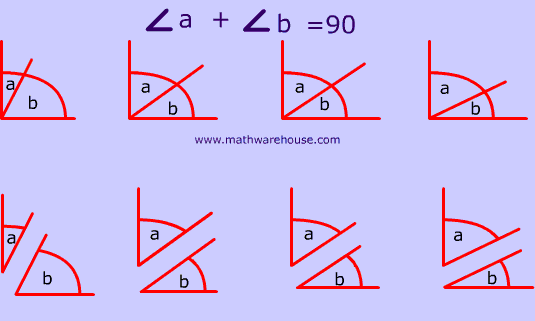What are complementary angles?
They are angles whose sum is 90°.
Formula, Examples, diagrams and practice problems
They are angles whose sum is 90°.
No!
Complementary angles do not need to be adjacent angles (angles next to one another).
All of the pairs of angles pictured below are complementary.
Since the angles are complementary (note: the perpendicular symbol).
$$ a + 50° = 90° \\ a = 90° -50° \\ a = 40° $$
Since the angles are complementary (note: the perpendicular symbol).
$$ a + 57° = 90° \\ a = 90° - 57° \\ a = 33° $$
Since these angles are complementary we can set up the following equation.
$$ m\angle A + m\angle B = 90^{\circ} \\ $$
Now, substitute the known angle into equation and solve.
$$ 40^{\circ} + m\angle B = 90^{\circ} \\ 40^{\circ} \color{red}{- 40^{\circ}}+ m\angle B = 90^{\circ} \color{red}{- 40^{\circ}} \\ m\angle B = \color{red}{ 50^{\circ}} \\ $$
Since these angles are complementary we can set up the following equation:
$$ m\angle X + m\angle Z = 90^{\circ} \\ $$
Now, substitute the known angle into equation and solve.
$$ 22^{\circ} + m\angle X = 90^{\circ} \\ 22^{\circ} \color{red}{- 22^{\circ}}+ m\angle B = 90^{\circ} \color{red}{- 22^{\circ}} \\ m\angle B = \color{red}{ 68^{\circ}} \\ $$
Answer: 68 degrees.
First, since this is a ratio problem, we know that 2x + 1x = 90, so now, let's first solve for x:
$$ 3x = 90 \\ x = \frac{90}{3} = 30 $$
Now, the larger angle is the 2x which is 2(30) = 60 degrees.
Answer: 60 degrees.
First, since this is a ratio problem, we know that 7x + 2x = 90, so now, let's first solve for x:
$$ 9x = 90 \\ x = \frac{90}{9} = 10 $$
Now, the smaller angle is the 2x which is 2(10) = 20 degrees.
Answer: 20 degrees.
$$ m\angle A + m\angle B = 90 \\ x + m\angle B = 90 $$
Now, let's just solve for$$ \angle B $$
$$ x + m\angle B = 90 \\ x \color{red}{- x} + m\angle B = 90\color{red}{- x} \\ m\angle B = \color{red}{90 - x} $$
